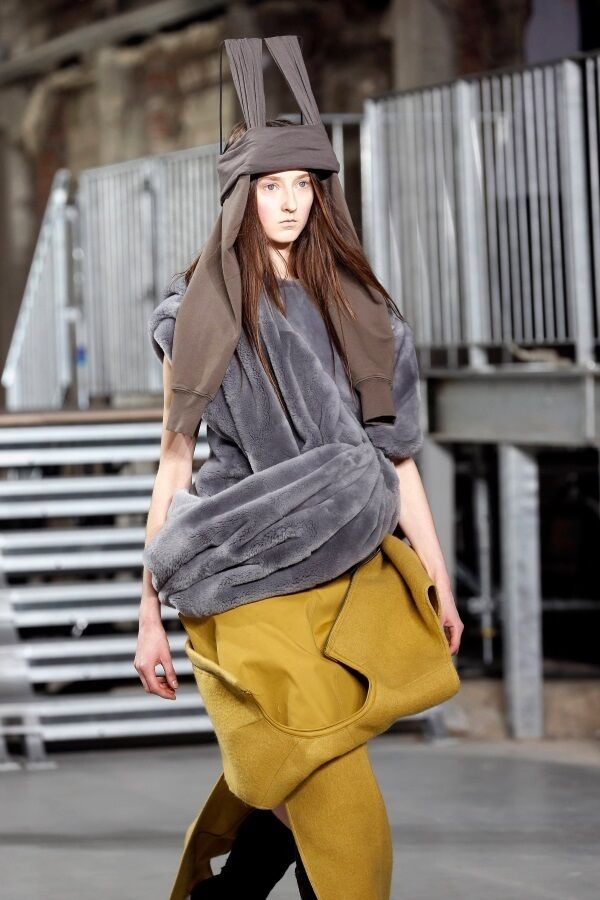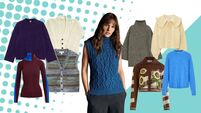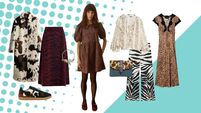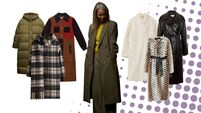Rick Owens may be the designer of our time

You kind of want the fashion designer Rick Owens to be a monosyllabic, misanthropic recluse. It’s what the embodiment of his clothes should be, if we were going by some unwritten aesthetic script. After all, the fashion Owens presents four times a year, for men and women, on the grand Paris stage, isn’t free and easy. It isn’t simple. It often looks like rags: Precious fabrics, like cashmere, are pilled and laddered, and leather is repeatedly washed to give it the texture and appearance of a prehistoric animal’s skin. There is something monstrous about his gothic garments, with their strange, disturbing proportions attenuated and exaggerated, draped like ectoplasm clinging to thin limbs. When people wear them head to toe, as Owens’s most enthusiastic followers frequently do, they don’t look human. They look other.
“Troll clothes for the most desperate lemmings in the fashion herd,” one observer wrote in 2008 on The New York Times’s On the Runway blog. Owens appreciated the sentiment so much that he ran the phrase on his website, alongside near-universal plaudits from the rest of the fashion world.
There is, however, a disconnect between Rick Owens the man and Rick Owens the fashion designer. In photographs, Owens looks arresting, even sinister, with his poker-straight black hair and shroudlike attire, like the Grim Reaper crossed with a West Coast surf bum. (He often wears diaper-wrap shorts and sneakers, which undermines the goth undertones.) His spiky, sharply drawn features appear a little cadaverous. Presented in print, Owens — generally quoted on topics such as death, renewal, creation — can come across like a prophet of the apocalypse. And those monstrous “troll clothes” he designs often seem, at first glance, cold and hard, solid carapaces of fabric, sharply cut and difficult to wear.
“I miss archness,” he murmurs, as if by way of explanation. “I think there was an arch moment in the ‘40s in fashion, and I’m thinking forward, thinking about fashion cycles — that’s kind of a good cycle to bring back.”
But there’s something unexpectedly soft about Owens, both the man and his clothes. In person, he’s preternaturally tanned (he holidays in the United Arab Emirates, “the shortest flight to the most sun”), and his voice, a languid Californian drawl, redolent of the state where he lived until the age of 42, softens his
doomsday portents. It adds both a humanity and a note of wry humor that collapses any perceived pretension. And in person, those clothes collapse too, in on themselves, softly wrapping the body in protective layers of felted fabric and down padding. Up close, his arch silhouettes prove light and pliable to the touch, seductive .
In the middle of the last century, the couturier Cristóbal Balenciaga was first applauded, then deified by the fashion press for achieving the selfsame, and his approach influenced an entire generation of designers. Owens’s technique has stealthily proved just as influential. Balenciaga probably didn’t compare an especially visceral bunch of drapery to anal prolapse, as Owens has. But then he also, to my knowledge, didn’t confess to an interviewer that he dyes his own hair.
“I’m thinking I better shut up now,” Owens says, almost as an aside. The delivery is so deadpan it begs for a punchline.
“Is it possible for designers to talk too much, do you think?”
He smiles, but thankfully doesn’t stop talking. Owens is 55, and was born in Porterville, California, a small city in the San Joaquin Valley.
He moved to Los Angeles after graduating high school, originally studying fine art at the Otis Art Institute of Parsons School of Design, then dropping out after two years.
“I wanted to be an artist at the beginning,” he says. “But then I didn’t think I had it in me. I didn’t think I had the intellectual stamina for it, so I decided to be a fashion designer, because that was frivolous and easy.”

Owens smiles wider. He is, again, deflating the myth that has grown around him. He doesn’t take himself as seriously as his work would lead people to believe. Unlike many fashion designers, however, Owens is able to articulate, precisely and vividly, what he’s trying to do with his clothes, namely talk about those big, overarching themes affecting humanity, and offer something different in the fashion landscape. When he talks, he makes you take him seriously. And he likes to talk.
We meet in Paris to discuss his men’s wear which, perhaps even more so than his women’s wear, is revolutionary, and has proved groundbreaking in its influence. In a soupy sea of mediocre suiting and sportswear, he offers something entirely different from other designers. He boldly experiments with fabric and silhouette, pushing boundaries of sexuality and gender. Owens is as likely to propose a dress for a man as for a woman, but without sacrificing manliness in favor of runway novelty. “My stuff seems to attract guys that I think might want to consider themselves some kind of heroic lone wolf, kind of playing by their own moral codes,” Owens says, slowly.
“I was thinking about men’s fashion, I was thinking in the ‘80s Calvin Klein, he promoted male sexuality ... males as an object of sexual attention. That was what happened then, and then in the ‘90s men’s fashion was a reaction to that and it became about youth. It became skinny and slim and young and introspective and vulnerable. Now, what is now?”
He stops. “If the last cycle was vulnerability, the obvious reaction would be heroism.”
Heroism for Owens isn’t about the barrel-chested jacket or thigh-gripping pants. It isn’t about any cliché of dressing. Owens has created collections inspired by Nijinsky’s performance in “Afternoon of a Faun,” and by the athletic silhouette of Fred Astaire. In both he used drapery instead of tailoring, garments twisted and captured in motion, seemingly frozen in frenzied, balletic movement. He also jokingly stated a collection was inspired by “tops” and “bottoms” — not the garments, but rather the words denoting sexual preference in the gay vernacular (Owens is bisexual).
For spring, Owens produced a remarkable collection, pumped with eye-socking colors of putty pink, peppermint and sulphuric yellow. But it was the silhouette that made the strongest impact: jackets abbreviated high on the torso, pants billowing organically around the leg, like a fusion of languid ‘30s styles — Owens loves that period — and wide-cut skater trousers. It seemed totally out of place at a moment when other men’s wear designers showed either generic sportswear or predictably straight suiting.
Owens isn’t overtly interested in tailoring, the linchpin of the masculine wardrobe since the early 19th century. You seldom see anything approaching a suit jacket in his shows. “I’m not going to be [who] somebody trusts for tailoring over Dior,” Owens says.
“Even one of my partners. For his wedding, he wore Dior!”
What he does offer is an alternative to the general thrust of fashion. And it’s seductive. His business is relatively small. His turnover is approximately $140 million, paltry when compared to the billion-dollar luxury behemoths. But it’s perfectly formed. “My mantra for everybody is better, not bigger,” he says.
“But it’s hard. When there’s a group of people together, they’re thinking of the team, and you want to win. Sometimes commercial success is a little bit more tangible than aesthetic success.”
Yet for all those disparaging comments about fashion lemmings, and the hordes of devotees clustered outside Owens’s shows in his most extreme looks, a core of his business comes from older, fashionable women and men, for whom a skinny-sleeved asymmetric Rick Owens jacket is the dernier cri of off-duty elegance. He also has a substantial celebrity following, although he doesn’t care about things like that. He’s often dubbed a ‘cult designer’.
“I hear the word cult used a lot,” he admits. “Which means you have a following, but you never hit the popular big time.” But by his own estimations, Owens is not a cult designer.
Like the Chanel jacket in the ‘50s, his leather biker jacket has become part of a uniform of our times. Pay attention, and you’ll see it endlessly copied.
Owens’s output is prodigious. Alongside his men’s and women’s runway lines and their commercial offshoots, he creates two accessibly priced secondary lines: Lilies, a range of jersey-focused women’s wear, and Drkshdw, a more unisex streetwear incarnation that began as a denim collection. He also has a fur line, Hunrickowens (From 2003 to 2006, Owens was the creative director at the French furriers Revillon Frères). Owens designs nearly every facet of a contemporary wardrobe — outerwear and sportswear, accessories and shoes.
Or, rather, redesigns it. His sneakers, produced with Adidas and retailing for several hundred dollars a pair, don’t look like other sneakers.

With odd protrusions of rubber or leather, they resemble fossilized animal remains strapped to the body. His gloves sometimes have wings of leather, like dorsal fins. He also designs furniture. His dramatic pieces resemble great altars of Carrara marble or prehistoric slabs of 500,000-year-old petrified wood. A bed he designed looks like a sarcophagus crafted from alabaster, and weighs over a ton. Even Owens’s toilets, in each of his three homes, look like chalices of marble.
Owens’s fashion experience began in the commercial world of Los Angeles. After dropping out of art school, he worked for a factory that copied designer clothing in shoddier fabrics. In 1994, he started his own line, selling directly to retailers. He didn’t stage his first show in New York until 2002.
A year later, he relocated to Paris. He still doesn’t speak French, which he doesn’t mind. “I was just as isolated in Los Angeles as I am in Paris,” he says.
Owens is somewhat reclusive: He doesn’t go out much, his life revolving around his home, the gym and a couple of nearby restaurants.
He lives and works in a single building, the former headquarters of the French Socialist Party, on a grand square opposite the French parliament. The only windows in his studio overlook the quiet, deserted garden of the former Ministry of Defense. Here, his aesthetic is complete. The floors and many walls are raw concrete. Owens gutted the building when he moved in, but didn’t do much else. Raw wires hang from the ceiling. I’ve visited him here three times, in three different years. Eventually I understood I wasn’t standing in the middle of a renovation. It was already complete.
Owens lives with his wife of a decade, French-born Michèle Lamy, who is a creative force behind many of Owens’s endeavors. She co-designs a jewelry line with Loree Rodkin under the Owens umbrella named Hunrod (“Hun” is Owens’s pet name for Lamy, combined with Rodkin’s surname). She also collaborates with Owens on the design of his furs, and on his acclaimed furniture line, an exhibition of which is currently on view at the Museum of Contemporary Art in Los Angeles.
She walks in halfway through our discussions, clad head to toe in Rick Owens. Her teeth glisten with gold, her fingers are tattooed and stained black. Together, they look remarkable — fascinating and terrifying in equal measure. They seem perfectly at home in Owens’s odd clothes among a grouping of their anthropomorphic spindly chairs that resemble something out of “Beetlejuice.” “The furniture thing is really about completing ...” Owens stops, then continues: “Of completely creating my own planet.”
Near Owens’s studio window, a huge altarpiece of a table holds an arrangement of stone blocks, flowers and a skull. It looks eerily like a memento mori painting. He begins to talk about the darker themes within his work. His father, John, a former social worker, died in 2015, aged 95 — which prompted a series of introspective, somewhat nihilistic collections.
“How do you face decline gracefully?” he asks.
“I suppose it was because of Dad declining and me getting older and me thinking about how we face change and all of that. Ecological change, and political threat. Me thinking, Isn’t all of this stuff maybe just supposed to happen?”
He shrugs. “Our primal urge is to procreate. That’s one of the reasons that we’re on earth, our prime motivation is to procreate and to live forever. We’re doing our best to do both, so isn’t it inevitable that we just overcrowd it until something else happens? We just kill ourselves off? Something’s got to evolve.”
“It’s sociology and anthropology,” he says. “It’s just the way — that’s what happens in real life. In real life, the act of creation is defying death. I think it’s just that dumb and simple.”
Preamble aside, Owens isn’t feeling particularly dour. It’s early December, and he’s planning his fall 2017 men’s wear collection, which he’ll show a month later in Paris. He named his previous two collections “Mastodon” and “Walrus.” They concentrated on the primordial, with thoughts about mankind going the way of the dinosaurs. This season the theme is “Glitter.” “It’s going to be about joyful abandon,” he says. The show is inspired by glam rock, full of down-pumped silhouettes with a theatrical bent, a hint of Bowie, possibly meeting Wagner, whose music Owens loves. There are lots of operatic trains. It doesn’t contain sequins, or beading or, indeed, any glitter. “Sequins in a collection called ‘Glitter,’” says Owens, making a face at such banality. He’s saving the embellishment for his next collection, he says. It’s going to be called “Dirt.” “It was what can be as transgressive as possible for me,” Owens says. “Whenever I do anything transgressive, it’s never out of anger or just provocation. There’s usually something well intentioned, there’s a well-intentioned spirit behind it.” Owens pauses. He’s worried he’s talking too much again.
“It’s just going to start getting corny,” he reasons. “But there is another side of me that’s thinking not everybody reads those things. Not everybody is reading everything, so you should take every opportunity to put a positive message out whenever you can.”
Joy as transgression. It’s a fitting summary of Owens’s work, which, for all its subversion winds up feeling like a celebration of the power and energy of creativity. That Times comment on Owens’s website, disparaging his output, closed with the refrain: “A line needs to be drawn whereby credit is given to collections that deserve it. Too much talk is spent on too little.”
Owens’ collections deserve to be talked about, by us, and by Owens himself. They’ll be talked about by future generations, too, if Owens proves to be the Cristóbal Balenciaga of our time.
“I always think that the act of creation is your fight for immortality,” Owens says. “The energy of resisting death, and trying to be remembered in the best possible way.”
He says it lightly. Then he stops talking.








